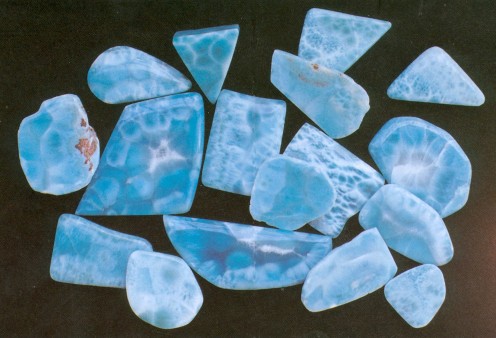
Natural Larimar in its most beautiful appearance
Picture: Jens Maier, Fa. Conlight
In 1974 a blue variety of the mineral pectolite (NaCa2[OH/Si3O8]) was discovered on the southwest coast of the Dominican Republic near Baoruco. Miguel Mendez, a local expert for arts and crafts products, coined the trade name »Larimar« because of the sea blue color of the stone ('mar' span. = sea) and in honor of his daughter Larissa.
When the »Larimar« deposits along the coast were exhausted, Mendez continued prospecting in the mountains further inland. At a distance of about seven kilometers from the coast he discovered a small primary deposit - so far the only known deposit of blue pectolite on earth.
»Larimar« is found in veins and coarse masses ranging from a few millimeters to several centimeters in size. They formed mainly along the shear zones of a hydrothermally transformed serpentinite body. The color varies from blue, light blue, turquoise blue and light green to silky white shades. The quality is defined by the intensity of the blue color - the more intense the blue, the higher the quality. The element copper, which is also concentrated in small black inclusions of chalcocite, is responsible for the coloration.
Due to its fibrous nature the stone is very brittle. It can often only be processed with great losses. It is common that only about 10% of the raw material remains after cutting and polishing. Because of the big effort, the small amount of material of good quality and the very high losses during processing, Larimar is offered mainly in the upper price range. This in turn makes the stone attractive for falsifiers.
Imitations
Gemmological investigations by the EPI Lab showed, that a material offered on eBay as "Real Larimar" consisted of 100% artificial glass. The glass imitation had a light blue, translucent appearance with zones that were in part more transparent (see Fig. 2). The polished specimens carried small, roundish cavities on the surface, which are the outbreaks of little air bubbles (see Fig. 3). The radial growth structures typical for Larimar are missing.
Lookalikes
In addition, there are some natural minerals which may be confused with larimar and are sometimes "mistakenly" offered as such. Especially blue calcite and aragonite, smithsonite and hemimorphite, as well as wardite are sometimes confused with »Larimar«.





